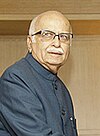Indian general election, 1991
|
|
|||||||||||||||||||||||||||||||||||||||||
|---|---|---|---|---|---|---|---|---|---|---|---|---|---|---|---|---|---|---|---|---|---|---|---|---|---|---|---|---|---|---|---|---|---|---|---|---|---|---|---|---|---|
|
|||||||||||||||||||||||||||||||||||||||||
|
All 545 seats in the Lok Sabha 273 seats were needed for a majority |
|||||||||||||||||||||||||||||||||||||||||
|
|||||||||||||||||||||||||||||||||||||||||

|
|||||||||||||||||||||||||||||||||||||||||
|
|||||||||||||||||||||||||||||||||||||||||
General elections were held in India in 1991 to elect the members of the 10th Lok Sabha. The result of the election was that no party could get a majority, so a minority government (Indian National Congress with the help of left parties) was formed, resulting in a stable government for the next 5 years, under the new Prime Minister P.V. Narasimha Rao.
The 1991 Indian general election were held because the previous Lok Sabha had been dissolved just 16 months after government formation. The elections were held in a polarised environment and are also referred to as the 'Mandal-Mandir' elections after the two most important poll issues, the Mandal Commission fallout and the Ram Janmabhoomi-Babri Masjid issue.
While the Mandal Commission report implemented by the VP Singh government gave 27 per cent reservation to the Other Backward Castes (OBCs) in government jobs, it led to widespread violence and protests across the country by the forward castes. Mandir represented the hallmark of this election, where there was a debate over the disputed Babri Masjid structure at Ayodhya, which the Bharatiya Janata Party was using as its major election manifesto.
The Mandir issue led to numerous riots in many parts of the country and the electorate was polarised on caste and religious lines. With the National Front was falling apart, the Congress managed to make the most of the polarisation, by getting the most seats and forming a minority government.
...
Wikipedia



